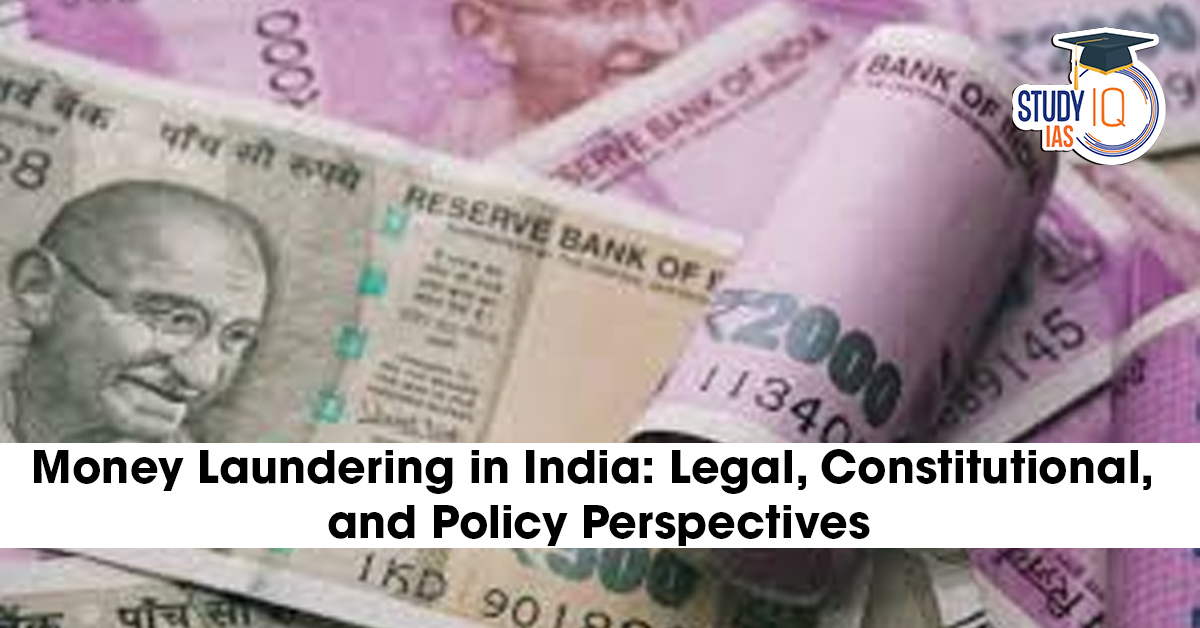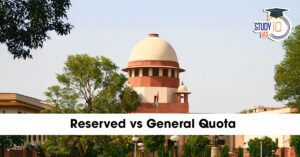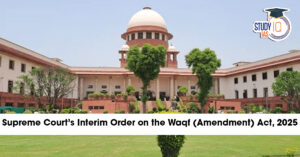Table of Contents
Money laundering constitutes a significant financial crime in contemporary society, eroding national economies, destabilising financial systems, and jeopardising the integrity of governance frameworks. In India, despite the existence of rigorous legislation like the Prevention of Money Laundering Act (PMLA), 2002, the prevalence of money laundering is growing significantly.
A recent report presented by the Finance Minister in the Rajya Sabha indicates that since 2015, the Enforcement Directorate (ED) has initiated procedures in 5,892 instances under the PMLA. However, only 15 convictions have been secured. This pronounced disparity between investigations and convictions underscores institutional inefficiencies and potential abuses of power.

Understanding Money Laundering: Definition and Mechanisms
- Money laundering is the act of concealing or masking the source of illicit funds to render them seemingly legitimate.
- Section 3 of the PMLA includes conduct involving the concealment, possession, acquisition, use, or representation of proceeds of crime as legitimate property. The money laundering process generally has three phases:
- Placement: The introduction of unlawful funds into the financial system, frequently accomplished by dividing substantial amounts into smaller payments, a process referred to as “smurfing.”
- Layering: The process of obscuring the origin of funds by executing many transactions across various places, including investments in diverse jurisdictions.
- Integration: The reinsertion of laundered cash into the economy via legitimate channels, such as real estate, enterprises, or asset acquisitions.
- The Supreme Court in Chidambaram v. Enforcement Directorate (2019) noted that money laundering undermines the financial system and jeopardises the sovereignty and integrity of the nation. It amplifies the money supply, destabilises monetary policy, intensifies inflation, and affects trade relations, as acknowledged by the Financial Action Task Force (FATF).
The Concept of a “Laundromat”
- The term “laundromat“ derives from organised crime syndicates in the U.S. that utilised laundromats to legitimise unlawful profits.
- A laundromat, in a financial sense, serves as a multifaceted entity enabling:
-
- Money laundering of illicit gains
- Concealing asset ownership
- Tax evasion or violation of currency regulations
- Transnational transfer of capital
- These procedures are crucial in India because of insufficient enforcement, gaps in tax legislation, and limited cross-border information exchange.

Legal Framework: The Prevention of Money Laundering Act (PMLA), 2002
- India implemented the PMLA in 2002 to conform to the UN Political Declaration and Global Programme of Action (1990) and later international treaties addressing money laundering and terrorism financing.
- The Act seeks to inhibit the laundering of proceeds from certain offences, seize property associated with such activities, and impose severe penalties.
Framework of the Legislation
- Burden of Proof: Resides with the accused to demonstrate that the property in question is untainted.
- The Enforcement Case Information Report (ECIR) serves as an alternative to a First Information Report (FIR), enabling the initiation of proceedings without the necessity of prior criminal case registration, as affirmed in Vir Bhadra Singh v. ED (2017).
- Attachment and Confiscation: Properties suspected of criminal association may be provisionally attached before conviction.
- Scheduled offences: Predicate offences enumerated in the Act, essential for the prosecution of a money laundering case.
Judicial Decisions
- Vijay Madanlal Chaudhury v. Union of India (2022): The Supreme Court determined that a scheduled offence is requisite for prosecution under Section 3; however, proceedings for attachment under Section 5 may commence without a registered case. This clause, however, has been exploited by authorities for politically motivated ends.
- Chidambaram v. ED (2019): Reiterated the national security risk associated with money laundering.
Constitutional Dimensions of Money Laundering
The struggle against money laundering in India is grounded in various constitutional principles.
- Article 300A: The right to property is contingent upon lawful deprivation, pertinent to attachment and confiscation under the Prevention of Money Laundering Act (PMLA).
- Article 14: Right to equality and protection against arbitrary actions; the misuse of PMLA subverts this value.
- Article 21: Due process in criminal proceedings is inherent, necessitating equity in inquiry and prosecution.
- Article 51A(c): Obligation to adhere to international law, embodying India’s commitments under FATF and UN conventions.
- Federalism Concerns: The PMLA engages with state legislation on scheduled offences, prompting inquiries about overlap and jurisdiction.
Issues and Challenges in Tackling Money Laundering
Notwithstanding an effective legal structure, the subsequent difficulties endure:
- Low Conviction Rates: Merely 15 convictions from about 6,000 instances underscore investigation inefficiency.
- Misapplication of Law: The Enforcement Directorate has faced criticism for conducting politically motivated investigations and harassing adversaries.
- Procedural Arbitrary Powers: The capacity to attach properties without a preceding FIR facilitates potential abuse.
- International Cooperation Deficiencies: Notwithstanding Double Taxation Avoidance Agreements (DTAA) with 85 nations, cross-border monitoring remains inadequate.
- The connection to terror financing: Money laundering directly supports extremist activities, yet, collaboration with anti-terror agencies is inadequate.
Recent Developments and Global Context
- India’s adherence to FATF recommendations has enhanced due to more stringent reporting rules and information exchange protocols under the DTAA. Nonetheless:
-
- The FATF has expressed concerns about the usage of the PMLA for non-financial purposes.
- There is a growing demand for the establishment of independent oversight of ED proceedings.
- Global initiatives, such as the OECD Common Reporting Standards (CRS), seek to eliminate tax evasion loopholes by requiring automatic information exchange.
- The worldwide Anti-Money Laundering/Countering Financing of Terrorism (AML/CFT) guidelines underscore the necessity for transparency, proportionality in enforcement, and judicial oversight domains in which India requires improvement.
Five Essential Steps to Combat Money Laundering Effectively
1. Utilise Technology for Enhanced Searches
- Conventional manual searches may provide several false positives, complicating the identification of genuine threats.
- The utilisation of new technology, especially AI-driven tools, enables banks to analyse substantial transaction volumes with enhanced accuracy and immediacy.
- This minimises superfluous alarms, allowing AML teams to concentrate on high-risk accounts and enhance reporting efficiency.
2. Enhance Cooperation with Law Enforcement
- Consistent contacts between financial institutions and law enforcement organisations facilitate the exchange of intelligence regarding emerging fraud strategies and anomalous tendencies.
- Banks frequently identify schemes before authorities, rendering this information exchange essential for establishing a cohesive response against money launderers.
3. Utilise Data Analytics to Identify Patterns
- Data analytics facilitates the identification of complex laundering strategies based on geographical location, account classifications, or client profiles.
- Real-time monitoring enables banks to identify high-risk consumers promptly, averting the loss of funds before the initiation of investigations.
4. Standardise Systems Among Institutions
- Numerous banks function with a combination of antiquated and disjointed systems as a result of previous mergers.
- Establishing a cohesive digital architecture with uniform definitions and data-sharing protocols enhances communication and fortifies anti-fraud measures across all sectors.
5. Implement Systematic and Ongoing Training.
- Employees constitute the primary line of defence.
- Consistent training sessions enable front-end and back-end personnel to identify warning signs, such as atypical account activity or elder abuse.
- Committed trainers guarantee that all employees are informed about the latest AML methodologies and optimal procedures.
Recommendations for Strengthening Enforcement
- Independent Oversight: Formulate a judicial or parliamentary committee to supervise the operations of the ED.
- Time-sensitive Investigations: Ensure investigations and trials are expedited to improve conviction rates.
- Capacity Building: Educate financial intelligence units and investigators on forensic accounting methodologies.
- Cross-border Cooperation: Enhance cross-border collaboration by fortifying DTAA enforcement and aligning with OECD-G20 BEPS activities.

- Harmonise Stringency with Rights: Prevent capricious property seizures to safeguard Article 14 and 21 protections.
- Money laundering constitutes a significant danger to India’s financial stability, legal integrity, and sovereignty.
- The Prevention of Money Laundering Act, 2002, was established to align India with international norms; nevertheless, its execution is hindered by inefficiencies, political exploitation, and insufficient openness.
- Addressing money laundering necessitates not just rigorous legislation but also equitable, accountable, and technologically advanced enforcement systems that preserve constitutional rights and conform to international standards.
- India can ensure that its combat against money laundering is both effective and equitable solely through an autonomous, well-coordinated strategy.


 Reserved vs General Quota: Supreme Court...
Reserved vs General Quota: Supreme Court...
 Supreme Court’s Interim Order on the W...
Supreme Court’s Interim Order on the W...



















